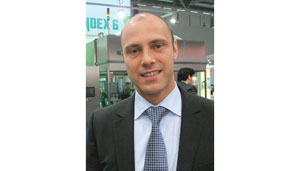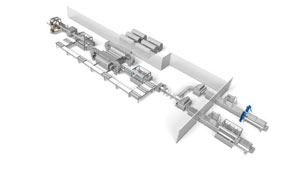Competition is proving to be a powerful driver for innovation and expanded possibilities for high-pressure processing (HPP) of solid and liquid foods. Flow Technologies was the only supplier of HPP presses throughout the technology’s first decade of commercial food applications, but after Flow spun off the food unit as Avure Technologies in the early 2000s, at least three additional HPP suppliers have joined the fray. Among them is Multivac GmbH, the packaging machinery manufacturer that forged a partnership last year with Uhde High Pressure Technologies, a business unit of ThyssenKrupp Group. Effective packaging remains a challenge, and Multivac has stepped outside its vacuum-pack comfort zone to develop modified atmosphere packaging (MAP) that can survive vessel pressures of up to 6,000 bar (87,000psi).2

|
|
Tobias Richter, senior manager—HPP & applied packaging solutions, Multivac Sepp Haggemüller GmbH & Co. KG, Wolfertschwenden, Germany.
|
HPP delivers nonthermal destruction of pathogens and spoilage organisms, thereby preserving the nutritional content and original taste and texture of food while extending its refrigerated shelf life. Before the technology was applied to food, industrial presses were used to squeeze oxygen out of high-performance metals, and processors have worked with a short list of containers that can withstand the stress. Throughput limitations in batch mode also are an issue. Besides engineering MAP containers, Multivac has designed an automated packaging line that moves HPP to semi-continuous production. In recognition, the company was presented with one of eight gold awards for food technology from DLG, the German Agricultural Society, at March’s Anuga FoodTec show in Cologne, Germany.
Directing Multivac’s HPP work is Tobias Richter, senior manager of the business unit overseeing HPP & applied packaging solutions. Dr. Richter joined Multivac in 2008 after completing work on a PhD in food technology-engineering at der Technische Universitaet Muenchen, the technical university of Munich. The focus of his doctoral thesis was food packaging, specifically the impact of HPP on a food container. Dr. Richter heads a core development team of six, with support from 200 other corporate engineers, scientists and technicians in the Multivac organization.
FE: Why did you choose to pursue MAP for in-container pasteurization with HPP?
Richter: Products in vacuum packages are everywhere, and they don’t convey the superiority of HPP as a food safety and shelf life extension technology. Additionally, if the package has ribs, the product itself will emerge from the press with those ribs outlined.
MAP is far more challenging to do, but with MAP, a whole new market can be opened, particularly in countries where MAP is widely used and associated with superior products. It also can provide longer shelf life than vacuum packaging.
FE: What happens to the gas in a modified atmosphere package when the package is subjected to high pressure?
Richter: When you increase the pressure beyond 200-300 bar (2,900-4,350psi), the gas is gone. The gas molecules are pressed into the polymer of the film and into the food. Once that has occurred, there is no additional impact, regardless of how high the pressure goes or how long it is maintained. When pressure is released, the molecules return to the enclosed atmosphere.
The increase in pressure to the set point and the release of pressure at the end of the cycle must be carefully controlled, or else white spots can appear on the surface of the food or the barrier property of the polymer can be compromised. Most HPP systems release their pressure within seconds. That can be devastating for MAP. Rapid depressurization results in micro-explosions in the package material, causing a loss of barrier property or destruction of the material. There also can be problems with the food itself. It begins exploding, and foaming could occur. The result is a loss of moisture, a package that appears wet and damage to the food.
The technical challenges in avoiding these problems are not difficult to figure out. A simple check valve is insufficient when controlling the release of extreme high pressure. There are physical differences in the machines we use, and the rate of decompression is adjusted, depending on the delicacy of the food itself.

|
|
The end-to-end solution for high-pressure processing from Multivac begins with automated or manual loading of pressure vessels and proceeds through unloading of pasteurized product (upper left). Tandem high-pressure presses immediately below that point are fabricated by Uhde. Source: Multivac Inc.
|
FE: What kind of lidding film is used?
Richter: Finding the right polyethylene polymers for a particular product is a major part of the studies and tests we conduct at our application center in Wolfertschwenden, Germany. Different materials have different levels of elasticity. If the film is too rigid, it won’t survive the process.
If a package doesn’t require barrier properties, at least two layers of film would compose the tray lid. If a high oxygen barrier is needed, there might be four to six layers. Whatever the film structure is, puncture resistance is another requirement.
FE: What types of package trays can survive extreme high pressure?
Richter: Pictures have been circulated of a foam tray subjected to HPP. It emerged with its shape intact but in a much smaller size. Thermoplastic polymers won’t withstand the process. Semi-rigid foam is required, and tiny differences can have a big impact. Fortunately, we have chemists and film experts on staff to analyze each application. Every product is its own project.
Package geometry also must be considered. Sharp edges won’t work. The package must be given a direction in which to collapse. It must be able to bend during compression and be elastic in some areas, rigid in others.
FE: What type of gas mixture is used?
Richter: There are mixtures that work better than others, but this is information we do not wish to share. However, it is correct to say that the particular mixture will vary depending on the food being processed. The moisture level of the product itself also can have an impact—the lower the moisture level, the less inactivation of any spoilage organisms that occurs. Generally speaking, microbial deactivation and good shelf life extension occur when the water content of a product is 16 to 18 percent.
FE: Have you encountered any issues with foods’ organoleptic properties as a result of HPP?
Richter: Preservation of the texture and nutritional value is the key advantage of homogeneous pressure, and there is little if any degradation in flavor, texture or vitamins. But color change can occur, and it’s well known that the reason is the denaturization of blood proteins.
Color change is primarily an issue with raw foods. If the protein already has been processed, the color change will be minimal or unnoticeable. If white fish undergoes HPP, it will appear whiter afterwards. If salmon or red meat undergoes HPP, it will start to turn grey.
FE: What is the relationship between Multivac and Uhde, which for decades has fabricated high-pressure equipment for industries, though not for food?
Richter: Uhde knows how to control the process and build the machine, and Multivac was looking for a partner or a supplier of high-pressure units, so we entered into a strategic partnership. But it’s a Multivac product with Uhde inside.
FE: Describe the elements of one of your integrated lines.
Richter: Our concept is to build a semi-continuous process with dual presses and an automated, integrated packaging line that includes product loading and unloading, labeling, weighing, inspection equipment and all other functions. The largest Multivac system is two 350-liter autoclaves in tandem. One press is loaded while the other executes a three-and-a half-to five-minute cycle. We have designed a foldable transport container that optimizes the amount of product that can be loaded, and the baskets facilitate rapid loading and unloading. It can be done manually, but we took design to the next step with robotics.
High-speed lines are good, but when they’re down, you’re in trouble. For the tandem system, we engineered a single pumping and intensifying unit. Our preference is to place the pumping system outside the production area, where maintenance and repairs can be performed if a pump or seal fails while production continues, although at a somewhat slower rate.
The first Multivac HPP 700 tandem system is being installed and should be operational by summer. We’re working on a dozen package concepts for this customer, and they involve MAP.
FE: Given the capital costs of a highly automated HPP line, is the technology limited to high-end, premium products?
Richter: Food safety is the key to HPP’s value add. The product itself shouldn’t be an issue. If you have a raw or ready-to-eat meat product and pathogens are a potential problem, you should take every step necessary. From my point of view, you have no excuses not to use the technology if it is available.
